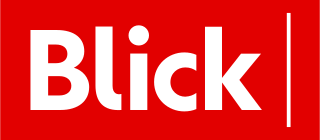Die Weltwoche is a Swiss weekly magazine based in Zürich. Founded in 1933, it has been privately owned by Roger Köppel since 2006.

Blick (View) is a Swiss German-language daily newspaper and online news website covering current affairs, entertainment, sports and lifestyle. Based in Zürich, it is the largest newspaper in Switzerland with a print circulation of around 285,000. The newspaper has been printed continuously since its inception in 1959.
Berner Zeitung, also branded as BZ, is a Swiss German-language daily newspaper, published by Tamedia in Bern.
Basler Zeitung, or BaZ, is a Swiss German-language regional daily newspaper, published in Basel.

20 Minuten is a free daily newspaper in Switzerland.

Adliswil is a town and a municipality in the district of Horgen in the canton of Zürich in Switzerland.

TX Group AG is a media company headquartered in Zurich, Switzerland. Through a portfolio of daily and weekly newspapers, magazines and digital platforms, as well as own printing facilities, it is the largest media group in the country. Since 2000, Tamedia has been listed on the Swiss Stock Exchange.
Tages-Anzeiger, also abbreviated Tagi or TA, is a Swiss German-language national daily newspaper published in Zurich, Switzerland.
FACTS was a weekly news magazine from Switzerland owned by Tamedia. The weekly published between 1995 and 2007.

News was a Swiss German-language free daily newspaper, published by NP News Print AG between 2007 and 2009.
Zürichsee-Zeitung, commonly shortened to ZSZ, is a Swiss German-language daily newspaper, published in Stäfa.
Beobachter (Observer), also known by its former name Der Schweizerische Beobachter, is a German-language Swiss magazine. Published in Zürich, its 26 issues a year focus on consumer, health and political content.
Bilan is a biweekly business magazine published in Geneva, Switzerland. The magazine has been in circulation since 1989.

Schweizer Familie is a weekly family magazine published in Switzerland. Founded in 1893, it is one of the oldest magazines in the country.
Bolero is a fashion and lifestyle magazine based in Zürich, Switzerland. It has been in circulation since 1990 and published monthly.
Edelweiss was a Swiss monthly women's magazine published in Zürich, Switzerland. The magazine was part of Ringier. It was among the best-selling women's magazines of Switzerland. It was in circulation between 1998 and 2015.

Rudolf "Ruedi" Noser is a Swiss businessman and politician who served on the Council of States (Switzerland) for The Liberals from 2015 to 2023. He previously served on the National Council (Switzerland) from 2003 to 2015.
Jasmin Staiblin is a German manager. She was the CEO of the Swiss energy group Alpiq 2013-2018. She was also the CEO of ABB Switzerland from 2006 to 2012.

Du is a magazine focused on art and culture, headquartered in Zürich, Switzerland. It was founded in 1941 and was often viewed as one of the leading voices on art and culture in Europe. The magazine is known for its focus on photography; prominent photographers such as Henri Cartier-Bresson, Werner Bischof and Réne Burri were contributors for the magazine.








